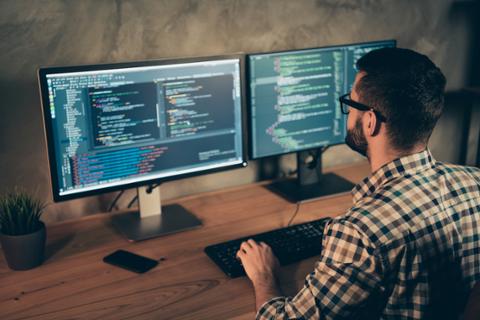The hunt for a new job can be stress-inducing even under the best of circumstances. With the COVID-19 pandemic still raging, many job seekers must contend with remote hiring processes—something that requires a unique approach, especially with regard to video interviews.
For technologists who may have to demonstrate problem-solving skills and/or employ the use of a whiteboard in the course of those remote interviews, it’s important to know what to expect. If the interview is memorable for your outstanding performance, and not a litany of technical glitches and awkward pauses, you have a higher chance of impressing the hiring manager and actually landing the position.
Small Technical Details
According to Joblist CEO Kevin Harrington, those technologists pursuing new jobs right now must get as familiar as they can with every aspect of the interview process: “Expressing proficiency with the technology the position requires is imperative, but candidates should also ensure that they're covering their bases when it comes to the seemingly smaller details.”
For example, a Joblist survey of 700 people found 27 percent of employers said something as simple as having good audio quality could make an applicant stand out.
“Voicing your thought process is a key to success in many IT interviews, so recording yourself in a mock interview can be helpful as well,” Harrington explained. “Writing things down when practicing will prepare you well if there are remote skill assessments where you need to show your work through a screen share, virtual whiteboard, or other testing application.”
Employers want to hire people who are good communicators, he noted, adding that more than half of hiring managers cited being a good conversationalist as a way that candidates can distinguish themselves. “Try to relax and be yourself — even though the interview may be virtual, facial expressions and hand gestures are a good way to build rapport and make the interview feel more like a normal in-person conversation,” he said.
As Harrington also pointed out, having good-quality lighting is another important element to consider, especially if employers must read something you’ve written (such as pseudocode on a whiteboard) via a video call.
Know Your Software (and the Interviewer’s Expectations)
Josh Drew, regional manager for the greater Boston area at IT staffing and recruitment agency Robert Half Technology, said that, for technologists, there is also the expectation (fair or not) that you’re comfortable navigating the app selected for a video interview.
“First and foremost, be prepared and in a quiet space with a good internet connection—a clean room with clean desk in front of you,” he said. “The other thing [is] dress appropriately for the interview. With startup environments, they might be more casually dressed, and you might stick out if you’re overdressed.”
When it comes to the technical aspects of an interview, such as problem solving or online code tests, interviewees should expect a range of formats. For example, the interviewer might send a link that will direct you in real time to a secure site where you’ll be presented with questions. You may also be asked to show your work in a digital format.
“We always encourage our candidates to be prepared to have their profile on GitHub at the ready, and be able to translate that experience into what the client needs, be it code samples… a whiteboard code test is something they should be prepared for,” Drew said.
Although some remote interviewers will send a technical test well in advance of the interview, some employers want any testing done live in front of them in order to verify the technologist’s actual skills.
“Setting expectations is key, so candidates are not surprised with impromptu tests,” Drew said, while suggesting that interviewees do their best to “go with the flow” of whatever the potential employer wants in terms of interview apps and software. You could always ask to use a different app for a virtual test, but that might “come off the wrong way.” Test any apps well in advance of the interview to make sure you’re comfortable with logging in and using them.
“Know how to turn the camera on, know how to mute yourself, and if you’re dealing with a true tech difficulty, be professional, acknowledge that you’re seeing a problem, and ask if that is popping up on their end,” he noted. “Don’t just power through, address it and try to work through it. If it’s a situation where you truly can’t fix on the fly, I would clarify the issue, and reschedule or give the interviewer options—don’t rush yourself off the phone.”
The Struggle to Replicate In-Person Interviewing
For Waikit Lau, co-founder and CEO of RemoteHQ, it’s important to acknowledge the struggle today to replicate the in-person interview, including switching between talking and whiteboarding.
“It is extremely difficult with the tools available today, and with video conferencing, when all you can do is screen share,” he said. “What we’ve seen with folks who have done successful interviews, they’ve cobbled together tools that allow you to pull in a whiteboard, or a shared virtual browser that both parties can control.”
Lau said the stakes for technologists can be higher—for especially for developer and engineer interviews.
“When you’re doing technical interviews, and you can test a person’s prowess and how collaborative the person is through things like paired programming and the ability to do code reviews of each other—a lot of good interviewers try to do this, where are the potential bugs, where could it be improved,” he said.
With a video interview, employers need to replicate as much of the in-person experience as possible. For example, it’s not just about evaluating skills; they want that back-and-forth that allows them to evaluate how the candidate responds to constructive criticism.
Beyond the technical issues, Lau said one easily overlooked—but critical—component to a successful video interview is lighting and its impact on conversation.
“A lot of interviewees don’t think about that, but being able to see facial expressions is really important,” he said. “Another critical piece of advice, which can be harder to do in remote interviews, is don’t be afraid to ask questions if you’re presented with a technical problem and you don’t understand it. It’s incumbent on the interviewer that the interviewee finds it as easy as possible to ask a question, so don’t be afraid to do that.”


